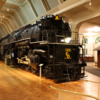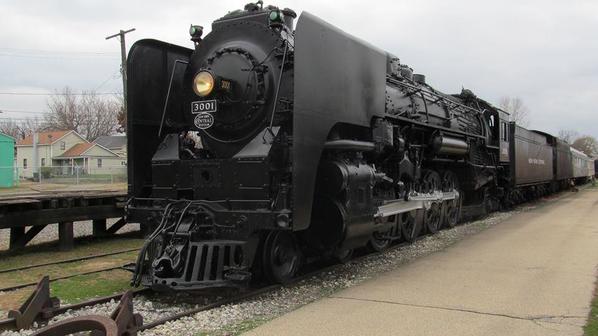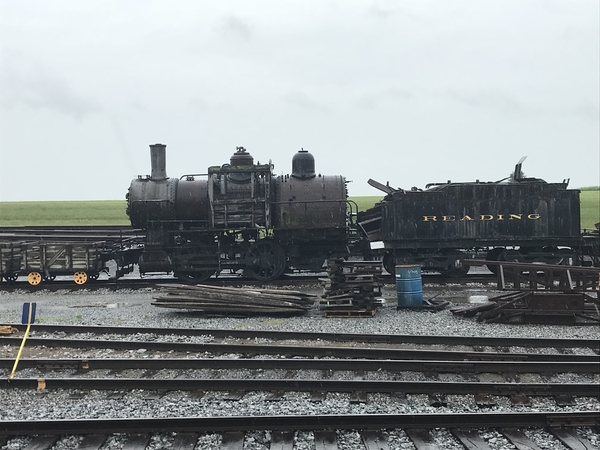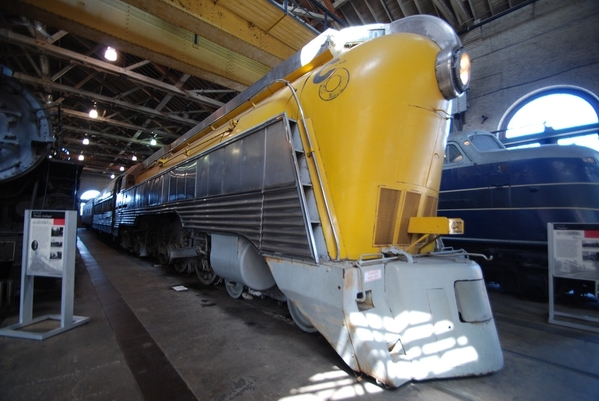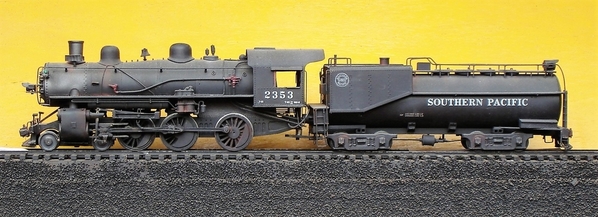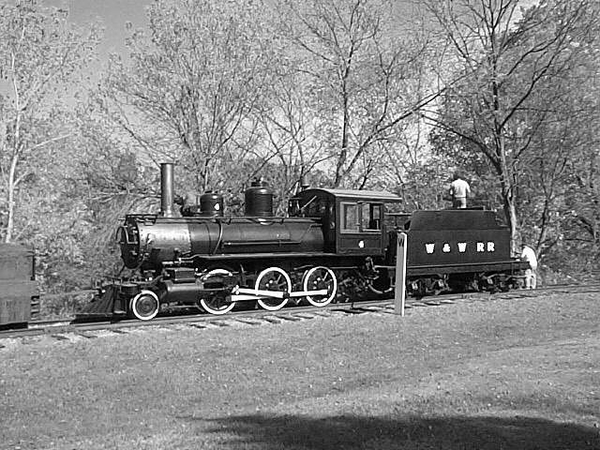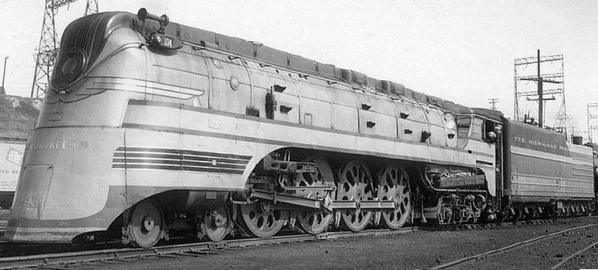I'm an N&W guy, but this is one...
jhz563 posted:
I don't know if you could operate a camelback with good conscience in 2018. However I would strongly support Strasburg trading for another piece of more traditional equipment at Steamtown and seeing #1187 assembled and preserved in the SNHS roundhouse as a static display.

My favorite engine on the deadline currently is MEC 519. For no reason in particular, she just has a great look to her. It's really hard to complain though when you take a look around - we are in a Steam Renaissance right now, whether the detractors realize it or not.
For me, another vote for the Southern Pacific cab forward on display in Sacramento. Such a different look and unique.
Attachments
jim pastorius posted:At least one of the East Broad Top Baldwins sleeping in the Orbisonia roundhouse.
What Jim said but; if wishes really could come true, it would be for the whole EBT to be operational again. This railroad is such a complete historical gem; it’s a shame it’s not open to the public and running trains.
Curt
Attachments
Lots of good selections here.
While I want to support my first interest road name, the Illinois Central, and see one of the two 4-8-2’s run again, the reality is that I would rather see the Santa Fe 3463 (Topeka, KS) in operation.
Visually, the very large drivers, is what I would like to see.
Charlie
There is a santa fe the queen 2-10-4.I would love to see that monster in operation.
Montclaire posted:I don't know if you could operate a camelback with good conscience in 2018.
Why not?
C&O 1309
Suprised no one said this, but I’d like to see NKP 759 running again. Honestly, we need more Berkshires fired up! They were great engines! That or N&W 1218.
Brody B. posted:Rule292 posted:My favorite ... too bad it's not the CNJ build!
Disclaimer - I didn't do any research as to the condition of the locomotive or it's restorability when I posted this.
Just saying I'd love to see it run AND I'd love to run it.
They cannot legally operate the locomotive. When F. Nelson Blount bought the locomotive for Steamtown, the locomotive's necessary to operate paperwork was lost in a fire. With no documentation, the locomotive couldn't run.
Interesting. I never knew that about it's paperwork. However. If it were to be torn down and restored, could the locomotive obtain new paperwork and run again?
smd4 posted:Montclaire posted:I don't know if you could operate a camelback with good conscience in 2018.
Why not?
They weren't always famed for being incredibly safe locomotives. By the way, how can the fireman know how much to fire it when he can't see the throttle position because the engineer is in another cab? Does he just listen to the stack?
Brody B. posted:smd4 posted:Montclaire posted:I don't know if you could operate a camelback with good conscience in 2018.
Why not?
They weren't always famed for being incredibly safe locomotives. By the way, how can the fireman know how much to fire it when he can't see the throttle position because the engineer is in another cab? Does he just listen to the stack?
Back in those days, the engine crews knew their districts, thus once they qualified as either an Engineer or a Fireman, the simply knew where they were and what to do. Besides, those old camelbacks were coal burners, and knowing EXACTLY what the throttle position was, was not quite as important as with an oil burning steam locomotive.
Hot Water posted:Brody B. posted:smd4 posted:Montclaire posted:I don't know if you could operate a camelback with good conscience in 2018.
Why not?
They weren't always famed for being incredibly safe locomotives. By the way, how can the fireman know how much to fire it when he can't see the throttle position because the engineer is in another cab? Does he just listen to the stack?
Back in those days, the engine crews knew their districts, thus once they qualified as either an Engineer or a Fireman, the simply knew where they were and what to do. Besides, those old camelbacks were coal burners, and knowing EXACTLY what the throttle position was, was not quite as important as with an oil burning steam locomotive.
Alright, Thanks Hot Water!
WITZ 41 posted:
I agree! That would look very neat, since there are no Hiawatha streamliners left. That's some slick photoshopping btw!
Brody B. posted:smd4 posted:Montclaire posted:I don't know if you could operate a camelback with good conscience in 2018.
Why not?
They weren't always famed for being incredibly safe locomotives. By the way, how can the fireman know how much to fire it when he can't see the throttle position because the engineer is in another cab? Does he just listen to the stack?
There were two main concerns with camel backs that I know of.
The first was crew communications. This could easily be overcome by any number of modern devices, a simple intercom would handle most issues.
The second was the possibility of a broken rod flying into the bottom of the cab. With modern inspection techniques, such as ultrasonic inspection of the crank pins at regular intervals, these problems would be highly unlikely in today’s operating environment. It would also be possible to add reinforcements under the cab for extra protection.
As far as the view ahead it would be better than most steam engines and at least on par with a gp-9 or other switching diesel. The view out the other side is obviously non-existent, but the fireman isn’t shoveling all the time.
Anyway, I think most of the safety concerns have readily available solutions today.
I would honestly love to see PRR 3750 run a doubleheader with 1361. Either that or to see PRR 6755 returned to operation as the only operating 4-8-2 in the US.
jhz563 posted:Brody B. posted:smd4 posted:Montclaire posted:I don't know if you could operate a camelback with good conscience in 2018.
Why not?
They weren't always famed for being incredibly safe locomotives. By the way, how can the fireman know how much to fire it when he can't see the throttle position because the engineer is in another cab? Does he just listen to the stack?
There were two main concerns with camel backs that I know of.
The first was crew communications. This could easily be overcome by any number of modern devices, a simple intercom would handle most issues.
The second was the possibility of a broken rod flying into the bottom of the cab. With modern inspection techniques, such as ultrasonic inspection of the crank pins at regular intervals, these problems would be highly unlikely in today’s operating environment. It would also be possible to add reinforcements under the cab for extra protection.
As far as the view ahead it would be better than most steam engines and at least on par with a gp-9 or other switching diesel. The view out the other side is obviously non-existent, but the fireman isn’t shoveling all the time.
Anyway, I think most of the safety concerns have readily available solutions today.
I had always heard that, with the cab over the boiler, they could be unreasonably hot for the operator.
prrhorseshoecurve posted:Brody B. posted:Rule292 posted:My favorite ... too bad it's not the CNJ build!
Disclaimer - I didn't do any research as to the condition of the locomotive or it's restorability when I posted this.
Just saying I'd love to see it run AND I'd love to run it.
They cannot legally operate the locomotive. When F. Nelson Blount bought the locomotive for Steamtown, the locomotive's necessary to operate paperwork was lost in a fire. With no documentation, the locomotive couldn't run.
Interesting. I never knew that about it's paperwork. However. If it were to be torn down and restored, could the locomotive obtain new paperwork and run again?
Yes, this has already been addressed. There are no restrictions on this locomotive save for the requirements of a Form 4.
As far as condition, she was overhauled in 58, retired in 59, and Blount only ran her for five weeks in 1961 before he was shut down. If this wasn't nearly 50 years ago I would say she would be in great shape. She was not included in the asbestos abatement project, which is a shame because we would have gotten a good look at her boiler.
smd4 posted:Montclaire posted:I don't know if you could operate a camelback with good conscience in 2018.
Why not?
I am sure that whatever the percentage of risk to life and limb is on a steam engine, that it is substantially higher on a camelback.
Adriatic posted:Protection from a loose rod will take some serious metal though. I don't see it happening in todàys sterile environment, despite wavers, speeds, x rays and my own want to see it happening.
Just how fast do you think that 0-4-0 teakettle is going to run? I assure you, at the 15 MPH she can probably travel, she's not going to break a rod.
Montclaire posted:smd4 posted:Montclaire posted:I don't know if you could operate a camelback with good conscience in 2018.
Why not?
I am sure that whatever the percentage of risk to life and limb is on a steam engine, that it is substantially higher on a camelback.
Nonsense.
smd4 posted:Montclaire posted:smd4 posted:Montclaire posted:I don't know if you could operate a camelback with good conscience in 2018.
Why not?
I am sure that whatever the percentage of risk to life and limb is on a steam engine, that it is substantially higher on a camelback.
Nonsense.
I agree, NONSENSE! Obviously another post from an individual with no railroad experience nor steam locomotive experience.
Hot Water posted:smd4 posted:Montclaire posted:smd4 posted:Montclaire posted:I don't know if you could operate a camelback with good conscience in 2018.
Why not?
I am sure that whatever the percentage of risk to life and limb is on a steam engine, that it is substantially higher on a camelback.
Nonsense.
I agree, NONSENSE! Obviously another post from an individual with no railroad experience nor steam locomotive experience.
Besides, it's not like conventional steam locomotives are immune:
Rusty
Attachments
The ICC banned them completely for safety issues in 1927 (construction of new ones, not further operation). That's a LONG time before OSHA. But I guess you know better?
Montclaire posted:The ICC banned them completely for safety issues in 1927 (construction of new ones, not further operation). That's a LONG time before OSHA. But I guess you know better?
Please provide written documentation of that "ban" by the ICC. I've heard that claim for more than 70 years (yes, I grew up on the Jersey Central RR in Cranford, NJ and saw them operate as late as 1955), and have not seen any published written proof of that "ban".
Montclaire posted:The ICC banned them completely for safety issues in 1927 (construction of new ones, not further operation). That's a LONG time before OSHA. But I guess you know better?
And yet, in 1959...
Trains Magazine: February 1959 Kalmbach Publishing Co.
Rusty
Attachments
Getting this thread back on track.
I'd like to see this beauty return to the rails:
And, not to be greedy:
Rusty
Attachments
Hot Water posted:Montclaire posted:The ICC banned them completely for safety issues in 1927 (construction of new ones, not further operation). That's a LONG time before OSHA. But I guess you know better?
Please provide written documentation of that "ban" by the ICC. I've heard that claim for more than 70 years (yes, I grew up on the Jersey Central RR in Cranford, NJ and saw them operate as late as 1955), and have not seen any published written proof of that "ban".
Who am I, your mother? Call the B&O museum and take it up with them.
(410) 752-2490
Camelbacks were given several different nicknames by engine crews. Employees of the Central Railroad of New Jersey referred to the Camelbacks as "Mother Hubbard" while the B&O employees called them the "Snapper." Similar to the B&O Camels of the mid-nineteenth century, Camelbacks were dangerous and impractical for the crew. The design was eventually outlawed by the Interstate Commerce Commission.
http://www.borail.org/CNJ-No-592.aspx
The Aug 2017 issue of OGR also mentions the 1927 ban, article by George Brown.
C&O #1309 and PRR #1361
Stuart posted:The difference is that on the 102 the side rod didn't go through the cab. On a Camelback quite often a broken side rod would slice through the cab, and the engineer as well.
"Quite often?" Just how often do you think camelback side rods broke?
The fact remains, getting that little camelback yard goat up and running wouldn't be unsafe for anyone. It's not going to break a rod, I promise. It's not going to be going 100 miles per hour (the estimated speed of that F7, above). The fireman won't fall to his death.
As Hot Water noted, it's really easy to tell the non-railroaders and folks with no steam experience when they make statements like "I don't know if you could operate a camelback with good conscience in 2018." Like it would be morally and ethically wrong or a deathtrap or something. That's just plain silly.
Rusty Traque posted:
I think (don't know for certain) that this is actually the same locomotive sitting in pieces at Strausburg.
A look at the Strasburg Railroad roster confirms that this indeed the same locomotive, originally Reading Company 1187, operated by the Strasburg from 1963 to 1967.
Attachments
smd4 posted:The fact remains, getting that little camelback yard goat up and running wouldn't be unsafe for anyone. It's not going to break a rod, I promise. It's not going to be going 100 miles per hour (the estimated speed of that F7, above). The fireman won't fall to his death.
I had to smile at the thought of that little 0-4-0 racing down the SRC main at high speed and throwing a rod. Funny thing is, now in 2018, I realize I saw that locomotive run at SRC, but don't remember it, after finding a photo from a family vacation recently. Wonder if I should add it to my list of steam locomotives I've seen operate.
Other options to run at 100 mph? Or even 40 mph? 592? Nope, it likely isn't ever leaving the roundhouse, as it is thought 592 broke the turn table main bearing when it was put in there, way back when, as the roundhouse (and turntable) was built as a passenger car repair shop and not built to take the weight of large locomotives. The bearing was fixed after the roundhouse collapse. Sort of a shame, as legend has it when 592 was briefly examined as a prospect to run steam on the "1st mile," it was found to be in reasonable shape, but the St Liz Porter needed less work and is a better locomotive the job.
I suspect the confusion that isn't so clear on the B&O information blurb is they reportedly banned making new Camelbacks, but didn't banning operating existing ones. Hotwater's request is valid, it would be interesting to see the actual documentation.
I have to 2nd Rich's vote for C&O 490, ironically, 2nd for me after C&O 1309. But perhaps we'll get to _hear_ a poppet valve locomotive with PRR 5550.
Bob
PS: Hotwater, was recently blessed to see #4449 in person for the first time. The cab floor is a piece of art!
smd4 posted:Stuart posted:The difference is that on the 102 the side rod didn't go through the cab. On a Camelback quite often a broken side rod would slice through the cab, and the engineer as well.
"Quite often?" Just how often do you think camelback side rods broke?
The fact remains, getting that little camelback yard goat up and running wouldn't be unsafe for anyone. It's not going to break a rod, I promise. It's not going to be going 100 miles per hour (the estimated speed of that F7, above). The fireman won't fall to his death.
As Hot Water noted, it's really easy to tell the non-railroaders and folks with no steam experience when they make statements like "I don't know if you could operate a camelback with good conscience in 2018." Like it would be morally and ethically wrong or a deathtrap or something. That's just plain silly.
There have been comments relating directly to 1187 and comments about camelbacks in general. I do not think anyone believes that 1187 is going to set any speed records. Other camels, like CNJ 592, were capable of 90mph and rumored to have gone 100mph. Now that engine I would consider to be a time bomb at speed.
On 1187, you don't have the speed to contend with but you still have the fireman's position which is obviously more precarious than in a traditional cab. While we are probably not talking about fatalities, your risk of injury would certainly be greater. And as we all know, nothing stops a rail preservationist group like a death of a employee, volunteer, or a bystander. Stay safe, stay under steam.





